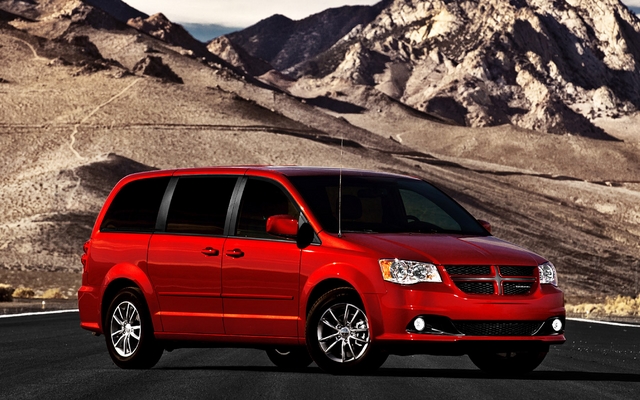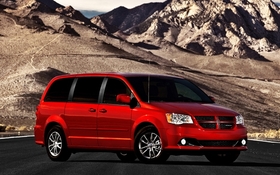The 2012 Dodge Caravan Crew: Commodious, Comfortable... Convincing?

| Strong points |
|
|---|---|
| Weak points |
|
When you’re the paltry age of 26, unmarried, and without even so much as the threat of children on the horizon, there’s a certain tactic that’s oftentimes employed after you’ve finished parking a minivan at the local supermarket. It’s called running. Away.
Because much like the Edward Scissorhands-style suburban life they represent, they just aren’t all that cool. They don’t go fast, they aren’t renowned for their unparalleled levels of luxury, and not a single famous person has been photographed doing anything remotely exciting, dangerous, or daring in one. But when it comes to practicality, they are quite simply without substitute. And when it comes to minivans without equal, there is but one: the Dodge Caravan.
And it’s come a long way; the Caravan, since the folks at Dodge created the segment out of thin air with possibly the ugliest box on wheels to ever… and then gave it the wood panel treatment. Hell, you wouldn’t even think that today’s Caravan was even related. With about as aggressive a countenance as you’re liable to find in this market, it’s not even ugly! In fact, with fresh LED taillights and a new, more stylized front fascia distinguish the 2011 model from previous years’ vans, it’s arguably the best looking of the minivan hordes… at least it is if you’re like me, and prefer that a minivan not look like a shuttlecraft departing from NCC-1701D.
But it’s not just another pretty face (obviously). The real party pieces are to be found on the lengthy options list. Granted, you can get nearly identical equipment from Toyota, Nissan, Honda and General Motors, but there are a few key differences. The first of which is the complete absence of the beautifully elegant Stow N’ Go system that’s been so popular since its invention a few years back. Allowing you to fold both middle and centre rows flat into the floor, it completely transforms the Caravan from a well-equipped people hauler into a convenient cargo car in less than two minutes, and offers commodious storage bins under the floor when you revert back to child chauffer. Similarly effective are the power doors and hatch located on either side of the van, and at the rear. Opened with either a tug on the handle or a push of the key fob, they make loading everything from lacrosse bags to groceries exceptionally easy, and give great access to every nook and cranny of the low-floored Dodge. In fact, the dual powered sliding doors were so effective that I found myself leaving the middle row of seats stowed most of the time, and simply tossed my luggage, bags, and other accoutrements of daily life in through the sliding doors more often than not. Even passengers enjoyed the arrangement, as it allowed for limo-like legroom and an apparently entertaining Starship Captain-style experience. That being said, such fantasies are significantly less interesting when you’re deemed to be the “Ensign at the helm” and are told to “Engage” whenever a light turns green. Apparently my friends are dorks.
And dorks love gadgets, which made a few other features quite popular amongst the minivan’s passengers; like the 110 volt outlet and A/V inputs. The only problem was that both are located rather awkwardly, at the aft of the driver’s side sliding door opening. This undoubtedly led to a few tangled cords, as accessories were moved and shuffled around. Had I my druthers, there’d be one outlet for each row, possibly on alternating sides of the vehicle. The LCD screens were popular as well, since they allowed for one screen to be displaying Star Trek: The Next Generation on boxed set while the rear was used for video games. As I said, dorks.
But, all that aside, the biggest difference between the options list of the Dodge Grand Caravan and that of its competitors is the bottom line. Take, for argument’s sake, the Toyota Sienna. A popular vehicle in its own right, and plenty capable, optioning out a Toyota Sienna to match my Grand Caravan Crew’s spec list culminated in a conveniently haggle-free $48,150 minivan, as compared to my incentive-laden $33,145 deal Dodge would offer… a difference of just over $15,000. And if you’re a dad who’s just been sentenced to a minivan, I don’t need to tell you exactly what sort of used sports cars and motorcycles fifteen grand can buy you.
Then again, maybe it wouldn’t be so bad, owning a minivan. After all, for all the ribbing, glib remarks, and jokes I had to endure, there wasn’t a single complaint to be heard from my friends… or myself. With a smooth, comfortable, and surprisingly quiet ride, decent power, and just about every option under the sun, it drives just like it does everything else: ridiculously easily. You needn’t think too much about the mechanics of what you’re doing or where you’re going, you simply need to give it the necessary guidance and then enjoy the ride. Instead of pondering the engine’s internal workings, or critiquing the transmissions operation, I found myself engaged in a much different manner; arguing the merits of Deep Space Nine versus Voyager. And I didn’t mind one bit. Maybe it was passing a bag of chips around while yelling over the staccato noises of Call of Duty: Black Ops paired with the silky smooth voice of Sir Patrick Stewart, or maybe it was seeing my friends stretched out, couch-style on the rearmost seats, but at some point it occurred to me that I wasn’t so much driving a minivan as I was moving my living room. And if there’s one thing you don’t do with a damn comfortable living room, it’s run away from it.











